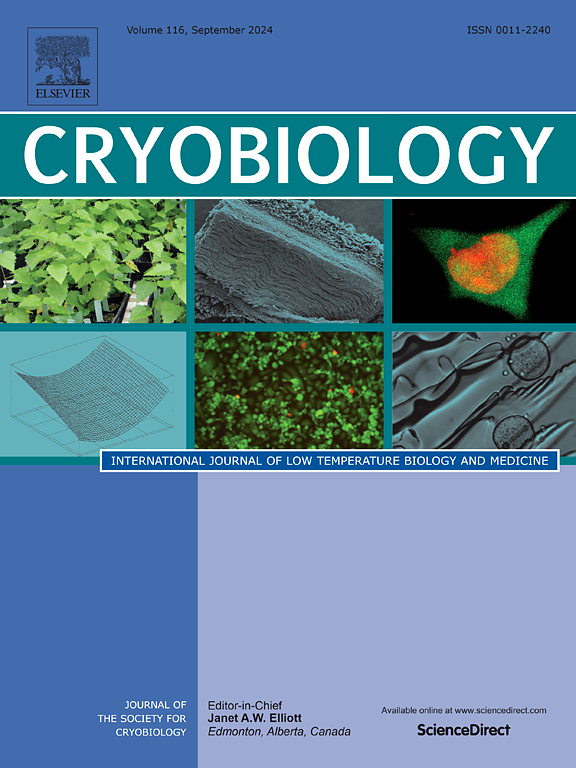一种优化卵母细胞和胚胎玻璃化冷冻的自动化装置的研制
IF 2.3
3区 生物学
Q2 BIOLOGY
引用次数: 0
摘要
卵母细胞/胚胎玻璃化是辅助生殖和保存生育能力的基本技术之一。然而,目前的过程通常需要由经验丰富的胚胎学家手动操作,这既耗时又结果不一致。为了解决这一问题,我们在此开发了一种用于卵母细胞/胚胎的自动玻璃化装置。该装置由微流体混合单元、微网格毛细管和机械滑动单元组成。采用微流控混合装置测定低温保护剂(CPA)浓度的连续变化,减少CPA加载/去除过程中的渗透损伤;微网格毛细管加载/移除CPA,玻璃化同一载体中的卵母细胞/胚胎,以减少细胞转移造成的细胞损失。将医用吸收敷料置于载体下,吸收多余的液体,以减少CPA加载后剩余的CPA溶液。采用自动玻璃化设备对卵母细胞进行玻璃化。我们的研究结果显示,基于二次函数的加载-去除曲线在8分钟加载和去除时间内获得了最高的卵母细胞存活率。此外,自动玻璃化装置与Cryotop多步平衡法的卵母细胞存活率差异无统计学意义(分别为90.33%和94.33%);这两种方法在8细胞胚胎的存活率和孵化率方面也没有区别。目前的系统自动化和标准化的卵母细胞/胚胎玻璃化过程,同时实现生存和发育潜力。本文章由计算机程序翻译,如有差异,请以英文原文为准。
Development of an automated device for the optimization of oocyte and embryo vitrification
Oocyte/embryo vitrification is one of the basic techniques employed in assisted reproduction and fertility preservation. However, the current process typically requires manual operation by experienced embryologists, which is both time-consuming and exhibits inconsistent outcomes. To resolve this issue, we herein developed an automated vitrification device for oocytes/embryos. The device consists of a microfluidic mixing unit, a microgrid capillary, and a mechanical sliding unit. The microfluidic mixing unit was adopted to determine continuous changes in cryoprotective agent (CPA) concentration, reducing osmotic damage during CPA loading/removal; and the microgrid capillary was used to load/remove the CPA and vitrify the oocytes/embryos in the same carrier so as to reduce cellular loss due to cell transfer. The medical absorbent dressing was placed under the carrier, and the excess liquid was absorbed to minimize the remaining CPA solution after CPA loading. Eight different loading/removal curves were developed for CPA loading and removal protocols, and we conducted oocyte vitrification with automated vitrification equipment. Our results revealed that a quadratic function-based, loading-removal curve achieved the highest oocyte survival rate within an 8-min loading and removal duration. In addition, there was no significant difference in oocyte survival rates between the automated vitrification device and the Cryotop multi-step equilibration method (90.33 % and 94.33 %, respectively); nor did the two methods differ in terms of survival or hatching rates of 8-cell embryos. The current system automates and standardizes the oocyte/embryo vitrification process while achieving survival and developmental potential.
求助全文
通过发布文献求助,成功后即可免费获取论文全文。
去求助
来源期刊

Cryobiology
生物-生理学
CiteScore
5.40
自引率
7.40%
发文量
71
审稿时长
56 days
期刊介绍:
Cryobiology: International Journal of Low Temperature Biology and Medicine publishes research articles on all aspects of low temperature biology and medicine.
Research Areas include:
• Cryoprotective additives and their pharmacological actions
• Cryosurgery
• Freeze-drying
• Freezing
• Frost hardiness in plants
• Hibernation
• Hypothermia
• Medical applications of reduced temperature
• Perfusion of organs
• All pertinent methodologies
Cryobiology is the official journal of the Society for Cryobiology.
 求助内容:
求助内容: 应助结果提醒方式:
应助结果提醒方式:


